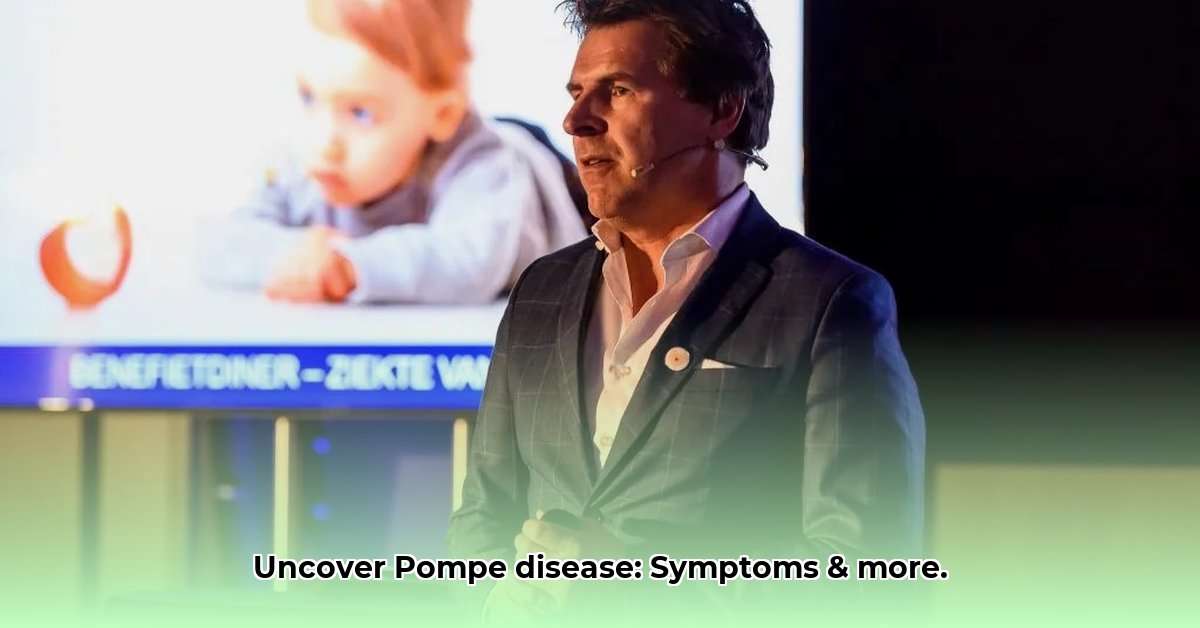
Pompe disease, or Ziekte van Pompe in Afrikaans, is a rare inherited disorder affecting how your body breaks down glycogen (stored energy in your muscles). This build-up causes muscle weakness and other problems. Understanding the symptoms is crucial for early diagnosis and management. This guide provides a clear, accessible overview, empowering patients, caregivers, and healthcare professionals.
Understanding the Different Types of Pompe Disease
The severity of Pompe disease depends largely on when symptoms first appear. Two main types exist:
Infantile-Onset Pompe Disease (Early Onset): Usually diagnosed in babies, this is the most severe form. Symptoms include difficulty feeding, breathing problems, weak muscle tone, and a significantly enlarged heart (cardiomegaly). Early intervention is vital due to its rapid progression.
Late-Onset Pompe Disease (Later Onset): Symptoms appear later in life, sometimes in childhood, adolescence, or adulthood. Early signs might be subtle, including progressive muscle weakness (especially legs and hips), breathing difficulties, and fatigue. This can impact daily activities, from climbing stairs to performing everyday tasks.
Remember, symptoms vary greatly. Some experience severe manifestations, while others have milder symptoms. Early diagnosis and management are key.
Recognising the Symptoms: What to Look Out For
Pompe disease symptoms can be subtle at first. However, as the condition progresses, several key indicators might appear. It's important to consult a doctor if you notice any of these signs:
Muscle Weakness: Progressive weakness, particularly in the legs and hips, makes tasks like walking, climbing stairs, or even standing difficult. This muscle weakness is a hallmark symptom. Have you noticed increasing difficulty with everyday tasks requiring physical strength?
Breathing Problems: Shortness of breath, even at rest, or during mild exertion, can indicate lung involvement. Are you experiencing breathlessness more often, even without strenuous activity?
Heart Problems: An enlarged heart (cardiomegaly) can occur, especially in infantile-onset Pompe disease. Regular heart checkups are vital for monitoring abnormalities.
Delayed Development in Infants: In babies, Pompe disease can delay developmental milestones, such as head control, sitting, and crawling. Are you concerned about your child's developmental progress?
Other Symptoms: Other potential symptoms include difficulty swallowing (dysphagia), frequent falls, and general weakness and fatigue. These can impact daily life and self-sufficiency.
Getting a Diagnosis: The Diagnostic Process
Diagnosing Pompe disease involves several steps, usually starting with:
Blood Tests: A blood test checks for elevated creatine kinase (CK) levels. CK is a protein released into the blood when muscles are damaged. High CK levels suggest damage to muscles.
Genetic Testing: This test identifies mutations in the GAA gene. This gene produces the enzyme (acid alpha-glucosidase) that breaks down glycogen. A mutation in this gene prevents proper glycogen breakdown.
Muscle Biopsy (If Necessary): A small muscle tissue sample is examined under a microscope to assess glycogen levels and confirm the diagnosis.
Managing Pompe Disease: Treatment Options and Lifestyle Adaptations
While there's no cure, various treatments aim to manage symptoms and improve quality of life:
- Enzyme Replacement Therapy (ERT): Regular infusions of alglucosidase alfa (e.g., Lumizyme) replace the missing enzyme. This helps break down excess glycogen; a crucial step in improving muscle function. It is a lifelong commitment requiring regular medical monitoring.
Dr. Elizabeth Smith, MD, PhD, Geneticist at the National Institute of Health, emphasizes the importance of regular ERT adherence for optimal outcomes.
Physical and Occupational Therapy: Tailored exercise programs and physiotherapy aim to improve strength, mobility, and overall function. Occupational therapy assists in adapting daily tasks to manage the challenges posed by muscle weakness.
Respiratory Support: If breathing difficulties emerge, respiratory support might include oxygen therapy, breathing machines, or ventilation. Early intervention reduces complications.
Supportive Care: A holistic approach includes nutritional advice, pain management, and emotional support from a multi-disciplinary team.
Living Well with Pompe Disease: Practical Tips and Emotional Support
Living with Pompe disease requires adaptation and a proactive approach:
Regular Medical Check-ups: Regular monitoring allows healthcare professionals to adapt the treatment plan as needed, ensuring optimal management of the condition.
Maintaining Physical Fitness (Modified): Gentle exercise tailored to fitness level maintains muscle strength and improves overall well-being.
Assistive Devices: Using wheelchairs, walking aids, or other assistive devices helps maintain independence and mobility.
Support Groups and Networks: Connecting with others facing similar challenges provides emotional support, valuable information, and the feeling of belonging.
Accessing Affordable Treatment: Navigating the Healthcare System
Access to ERT remains a significant hurdle for many due to the high cost. Here are some strategies:
Insurance Coverage: Check your health insurance plan’s coverage for ERT. Many plans cover the therapy. Contact your insurer for details about coverage.
Patient Assistance Programs (PAPs): Many pharmaceutical companies offer financial assistance programs. Inquire with the company that manufactures your prescribed ERT.
Government Assistance Programs: Investigate whether disability grants or other government assistance is available for Pompe disease in your province.
Charitable Organizations: Several organizations raise funds to assist families with the often-substantial cost of ERT. Research local and national Pompe disease support organizations.
Clinical Trials: Participation in clinical trials might provide access to ERT at a reduced cost or even for free.
The Future of Pompe Disease Treatment
Research into gene therapy and other novel treatment approaches offers hope for future improvements in Pompe Disease treatment options. Ongoing research continuously strives to improve the lives of those affected by this condition.
Remember, living with Pompe disease is a journey. With a supportive healthcare team, appropriate treatment, and accessible resources, you can live a meaningful life. Reaching out for help is a sign of strength, not weakness.